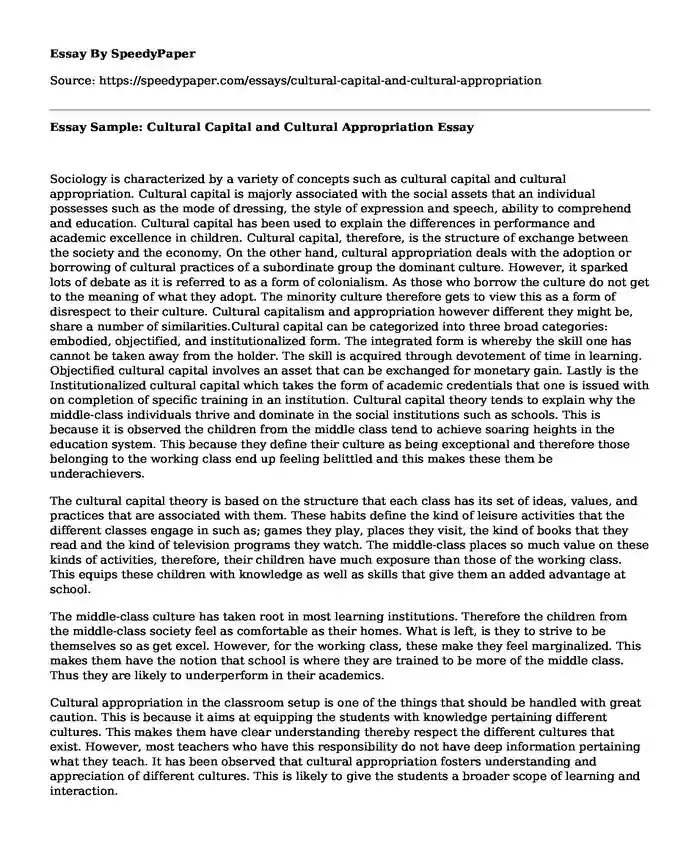Sociology is characterized by a variety of concepts such as cultural capital and cultural appropriation. Cultural capital is majorly associated with the social assets that an individual possesses such as the mode of dressing, the style of expression and speech, ability to comprehend and education. Cultural capital has been used to explain the differences in performance and academic excellence in children. Cultural capital, therefore, is the structure of exchange between the society and the economy. On the other hand, cultural appropriation deals with the adoption or borrowing of cultural practices of a subordinate group the dominant culture. However, it sparked lots of debate as it is referred to as a form of colonialism. As those who borrow the culture do not get to the meaning of what they adopt. The minority culture therefore gets to view this as a form of disrespect to their culture. Cultural capitalism and appropriation however different they might be, share a number of similarities.Cultural capital can be categorized into three broad categories: embodied, objectified, and institutionalized form. The integrated form is whereby the skill one has cannot be taken away from the holder. The skill is acquired through devotement of time in learning. Objectified cultural capital involves an asset that can be exchanged for monetary gain. Lastly is the Institutionalized cultural capital which takes the form of academic credentials that one is issued with on completion of specific training in an institution. Cultural capital theory tends to explain why the middle-class individuals thrive and dominate in the social institutions such as schools. This is because it is observed the children from the middle class tend to achieve soaring heights in the education system. This because they define their culture as being exceptional and therefore those belonging to the working class end up feeling belittled and this makes these them be underachievers.
The cultural capital theory is based on the structure that each class has its set of ideas, values, and practices that are associated with them. These habits define the kind of leisure activities that the different classes engage in such as; games they play, places they visit, the kind of books that they read and the kind of television programs they watch. The middle-class places so much value on these kinds of activities, therefore, their children have much exposure than those of the working class. This equips these children with knowledge as well as skills that give them an added advantage at school.
The middle-class culture has taken root in most learning institutions. Therefore the children from the middle-class society feel as comfortable as their homes. What is left, is they to strive to be themselves so as get excel. However, for the working class, these make they feel marginalized. This makes them have the notion that school is where they are trained to be more of the middle class. Thus they are likely to underperform in their academics.
Cultural appropriation in the classroom setup is one of the things that should be handled with great caution. This is because it aims at equipping the students with knowledge pertaining different cultures. This makes them have clear understanding thereby respect the different cultures that exist. However, most teachers who have this responsibility do not have deep information pertaining what they teach. It has been observed that cultural appropriation fosters understanding and appreciation of different cultures. This is likely to give the students a broader scope of learning and interaction.
Cultural appropriation is characterized by the inappropriate use of the minority culture's symbols, ideas, and artefacts. To the dominant culture, it is seen as an exchange of culture. However, this is not the case. This is because the acts that the dominant culture carries on the borrowed culture end up demining the minority culture. This is mostly exhibited in the fashion industry whereby they tend to cheapen the original brands while commercializing the new arrivals. This is done without the designers having a deeper insight into the actual value that the native fashion held.
Both cultural capital and cultural appropriation are similar to a given extent. In that, in both, there is one class of individuals that are deemed to be of a better class than the other. In cultural capitalism, the middle class is deemed to be better off than the working class. This is from the values, ideas, and norms that they uphold that makes them thrive in the school set up. However, in cultural appropriation, the minority culture is seen to be the subordinate to the dominant group. Dominant culture adopts the culture the minority culture without clearly having a clear understanding. They end up using what they have borrowed in other ways that seem disrespectful. This has led to the cultural appropriation to be seen as a form of colonialism.
Cite this page
Essay Sample: Cultural Capital and Cultural Appropriation. (2022, Apr 25). Retrieved from https://speedypaper.net/essays/cultural-capital-and-cultural-appropriation
Request Removal
If you are the original author of this essay and no longer wish to have it published on the SpeedyPaper website, please click below to request its removal:
- Free Essay Sample Discussing Racism in the Food System
- Free Essay on History of Europe
- Free Essay Sample on Effects of War
- Essay Example: Closing Down Some Stores by Post Corporation
- Creative Writing Essay Sample - The Missed Chapter of The Wars Book
- Essay Sample: Public/Private Versus Homeschooling
- Free Essay Example: Embroidery
Popular categories





